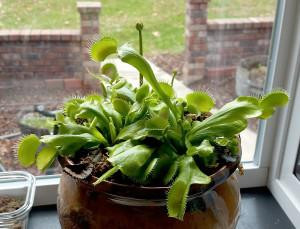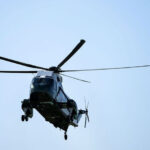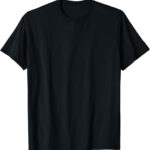Do Venus Fly Traps Need Flies To Survive? Yes, while Venus fly traps can survive without flies, they thrive when they occasionally supplement their diet with insects. This carnivorous plant utilizes photosynthesis to create energy, but insects provide essential nutrients that enhance growth and overall health, discover more insights on flyermedia.net.
1. Understanding the Venus Fly Trap
The Venus flytrap (Dionaea muscipula) is a fascinating carnivorous plant native to the subtropical wetlands of North Carolina and South Carolina in the United States. Its unique trapping mechanism and carnivorous diet have captivated plant enthusiasts and scientists alike. However, there are several common misconceptions about the plant’s needs. Let’s dive in.
1.1. What is a Venus Fly Trap?
The Venus flytrap is a small plant, typically reaching about 5 inches in height. It is characterized by its modified leaves, which form trap-like structures. These traps are lined with sensitive trigger hairs. When an insect or other small creature touches these hairs multiple times within a short period, the trap snaps shut, capturing the prey inside.
1.2. The Natural Habitat of Venus Fly Traps
Venus flytraps are native to the pine savannas of North and South Carolina. These environments are characterized by nutrient-poor, acidic soil, high humidity, and plenty of sunlight. Understanding their natural habitat is crucial to replicating suitable growing conditions. These plants thrive in well-drained soil, not swampy conditions, despite common misconceptions. According to the U.S. Fish and Wildlife Service, conservation efforts are in place to protect these unique habitats.
1.3. Photosynthesis vs. Carnivorous Diet
Venus flytraps are photosynthetic plants, meaning they produce their own food through photosynthesis. This process converts light energy into chemical energy using chlorophyll, water, and carbon dioxide. However, because they grow in nutrient-poor soil, they supplement their diet by trapping and digesting insects to obtain essential nutrients such as nitrogen, phosphorus, and potassium. Photosynthesis sustains the plant, but the carnivorous diet enhances its growth and vitality.
2. The Role of Insects in the Diet of Venus Fly Traps
Insects play a vital, yet not strictly necessary, role in the diet of Venus fly traps. Here’s a closer look at how insects contribute to the plant’s health and growth.
2.1. Why Do Venus Fly Traps Eat Insects?
Venus fly traps eat insects to obtain nutrients that are scarce in their native soil. The primary nutrient they gain from insects is nitrogen, which is crucial for protein synthesis and overall growth. Other essential nutrients obtained from insects include phosphorus, magnesium, and potassium. These nutrients enhance the plant’s ability to produce enzymes and proteins, promoting robust growth and vibrant health. The Carnivorous Plant Society provides detailed information on the nutritional needs of carnivorous plants.
2.2. The Digestion Process
When a Venus flytrap captures an insect, it seals the trap tightly and begins the digestion process. The plant secretes enzymes that break down the insect’s soft tissues, releasing nutrients that the plant can absorb. This process can take between five to twelve days, depending on the size of the prey and environmental conditions. After digestion, the trap reopens, leaving behind the indigestible exoskeleton.
2.3. What Types of Insects Do Venus Fly Traps Eat?
Venus fly traps typically eat small insects and arthropods that fit inside their traps. Common prey includes flies, ants, beetles, spiders, and grasshoppers. The size of the insect should be approximately one-third the size of the trap to ensure successful capture and digestion. Larger insects may struggle and damage the trap, while smaller insects may escape.
 A close-up of a Venus flytrap showing the trapping mechanism with trigger hairs
A close-up of a Venus flytrap showing the trapping mechanism with trigger hairs
3. Can Venus Fly Traps Survive Without Flies?
Yes, Venus fly traps can survive without flies, but their growth and overall health may be affected. The ability to thrive without insects depends on several factors, including the plant’s age, size, and environmental conditions.
3.1. The Importance of Photosynthesis for Survival
Photosynthesis is the primary means by which Venus fly traps obtain energy. Through photosynthesis, the plant converts sunlight, water, and carbon dioxide into glucose, which fuels its growth and metabolic processes. As long as the plant receives adequate light, water, and carbon dioxide, it can produce enough energy to survive.
3.2. How Long Can a Venus Fly Trap Live Without Insects?
A Venus fly trap can live for several months or even years without eating insects, provided it receives sufficient sunlight and water. However, during this time, the plant may grow more slowly and produce smaller traps. The lack of essential nutrients from insects can lead to a gradual decline in the plant’s vigor and resilience.
3.3. Signs of a Venus Fly Trap Not Getting Enough Nutrients
Several signs indicate that a Venus fly trap is not getting enough nutrients:
- Slow Growth: The plant grows at a slower rate than usual.
- Small Traps: The traps are smaller and less robust.
- Pale Color: The leaves and traps appear pale green or yellow.
- Weak Traps: The traps are slow to close or fail to close completely.
- Reduced Vigor: The plant appears weak and lacks its usual vibrancy.
If you notice these signs, it may be necessary to supplement the plant’s diet with insects or a suitable alternative.
4. Alternative Ways to Feed Your Venus Fly Trap
If you cannot provide live insects, several alternative methods can help supplement your Venus fly trap’s diet.
4.1. Freeze-Dried Insects
Freeze-dried insects, such as crickets or mealworms, are a convenient and readily available alternative to live insects. Before feeding, rehydrate the freeze-dried insects by soaking them in water for a few minutes. This helps to simulate the texture of live prey and stimulates the trap’s digestion process.
4.2. Beta Alanine
Beta-alanine, an amino acid, can stimulate the traps of Venus flytraps to close. According to research published in The American Journal of Botany, beta-alanine triggers electrical signals in the trap, mimicking the sensation of live prey. This method can be used to encourage trap closure and simulate feeding.
4.3. Nutritional Sprays
Specially formulated nutritional sprays designed for carnivorous plants can provide essential nutrients directly to the plant’s leaves. These sprays typically contain a balanced blend of nitrogen, phosphorus, and potassium. Apply the spray according to the manufacturer’s instructions, usually every few weeks during the growing season.
4.4. Fertilizers
Diluted orchid fertilizer, applied carefully, can provide nutrients to Venus flytraps. However, use extreme caution, as over-fertilizing can harm the plant. Dilute the fertilizer to one-quarter strength and apply it sparingly to the soil, avoiding direct contact with the traps. According to the International Carnivorous Plant Society, improper fertilization is a common cause of Venus flytrap decline.
5. How to Properly Feed a Venus Fly Trap
Feeding a Venus fly trap requires careful attention to detail to ensure the plant benefits from the meal without being harmed.
5.1. The Right Size and Type of Food
The size of the insect should be about one-third the size of the trap. This ensures that the trap can close completely and form an airtight seal for digestion. Avoid feeding the plant large or hard-bodied insects, as they can damage the trap.
5.2. Stimulating the Trap to Close
To stimulate the trap to close, gently touch the trigger hairs inside the trap with the insect. You need to stimulate the hairs twice within about 20 seconds. Once the trap is closed, gently massage the outside of the trap to encourage it to seal completely. This simulates the movement of live prey and triggers the plant to begin the digestion process.
5.3. How Often to Feed Your Venus Fly Trap
During the growing season (spring and summer), feed each trap about once every two to three weeks. Avoid feeding the same trap multiple times in a row, as each trap can only digest a limited number of meals before it expires. In the dormant season (fall and winter), reduce feeding to once a month or eliminate it altogether.
6. Common Myths About Feeding Venus Fly Traps
Several myths surround the feeding habits of Venus fly traps, which can lead to improper care and harm the plant.
6.1. Myth: Venus Fly Traps Need to Be Fed Constantly
Venus fly traps do not need to be fed constantly. They can survive for extended periods without insects, relying on photosynthesis for energy. Overfeeding can stress the plant and shorten the lifespan of the traps.
6.2. Myth: Feeding Venus Fly Traps Human Food
Never feed Venus fly traps human food, such as hamburger meat or sweets. Human food contains substances that the plant cannot digest and can lead to bacterial or fungal infections, causing the trap to rot and die.
6.3. Myth: Triggering the Traps Without Food Is Beneficial
Triggering the traps without providing food wastes the plant’s energy. Each trap can only open and close a limited number of times before it expires. Unnecessary triggering depletes the plant’s energy reserves and reduces its ability to capture prey.
7. Creating the Ideal Environment for Your Venus Fly Trap
To ensure your Venus fly trap thrives, creating an ideal environment is crucial. This includes providing the right soil, water, and sunlight.
7.1. Soil Requirements
Venus fly traps require nutrient-poor, acidic soil. The best soil mix consists of equal parts of peat moss and perlite or silica sand. Avoid using potting soil, garden soil, or fertilizers, as they contain minerals and nutrients that can harm the plant. The acidic pH of peat moss helps to prevent the buildup of harmful bacteria and fungi.
7.2. Water Requirements
Venus fly traps are highly sensitive to the minerals and chemicals in tap water. Therefore, you should only water them with distilled water, rainwater, or reverse osmosis water. Keep the soil consistently moist, but not waterlogged. Place the pot in a tray of water to allow the plant to absorb moisture from the bottom.
7.3. Sunlight Requirements
Venus fly traps need at least six hours of direct sunlight per day to thrive. Insufficient sunlight can lead to weak growth and pale coloration. If you are growing your Venus fly trap indoors, place it in a south-facing window or use a grow light to provide adequate illumination.
8. Common Problems and Solutions
Like all plants, Venus fly traps are susceptible to certain problems. Knowing how to identify and address these issues is essential for maintaining a healthy plant.
8.1. Rotting Traps
Rotting traps are often a sign of overwatering or fungal infection. Remove the affected traps and ensure that the plant is not sitting in standing water. Improve air circulation around the plant to prevent fungal growth. You may also consider using a fungicide specifically designed for carnivorous plants.
8.2. Blackening Leaves
Blackening leaves can be caused by a variety of factors, including insufficient sunlight, improper watering, or mineral toxicity. Assess the plant’s growing conditions and adjust as needed. Ensure that the plant is receiving adequate sunlight and that you are using distilled water. If mineral toxicity is suspected, repot the plant in fresh soil.
8.3. Slow Growth
Slow growth is often a sign of insufficient nutrients or inadequate sunlight. Ensure that the plant is receiving at least six hours of direct sunlight per day and that you are supplementing its diet with insects or a suitable alternative. Check the soil pH to ensure it is within the optimal range of 4.0 to 5.5.
9. Venus Fly Traps in Aviation
The principles behind the Venus fly trap’s trapping mechanism can be likened to the precision and timing required in aviation.
9.1. Precision and Timing
Just as a Venus fly trap relies on precise timing to capture its prey, aviation demands accuracy and timing in every aspect of flight. Pilots must execute maneuvers with precision, and air traffic controllers must coordinate movements to ensure safety and efficiency.
9.2. Adaptability
Venus fly traps adapt to their nutrient-poor environment by supplementing their diet with insects. Similarly, pilots and aviation professionals must be adaptable to changing conditions, such as weather patterns, mechanical issues, and emergency situations.
9.3. Maintenance and Care
Maintaining a Venus fly trap requires careful attention to its specific needs. Likewise, aircraft require regular maintenance and care to ensure they operate safely and efficiently. Aviation technicians must adhere to strict maintenance schedules and protocols to prevent accidents and ensure the longevity of the aircraft.
10. Frequently Asked Questions (FAQ)
10.1. Do Venus Fly Traps Need Flies to Survive?
While Venus fly traps can survive without flies, they benefit from the nutrients they obtain from insects.
10.2. How Often Should I Feed My Venus Fly Trap?
During the growing season, feed each trap about once every two to three weeks.
10.3. Can I Feed My Venus Fly Trap Human Food?
No, never feed your Venus fly trap human food.
10.4. What Kind of Water Should I Use?
Only use distilled water, rainwater, or reverse osmosis water.
10.5. How Much Sunlight Does a Venus Fly Trap Need?
Venus fly traps need at least six hours of direct sunlight per day.
10.6. What Type of Soil Should I Use?
Use a mix of equal parts peat moss and perlite or silica sand.
10.7. What Do Rotting Traps Indicate?
Rotting traps often indicate overwatering or fungal infection.
10.8. Can I Trigger the Traps Without Food?
Avoid triggering the traps without providing food, as it wastes the plant’s energy.
10.9. How Big Should the Insects Be That I Feed My Plant?
The insects should be about one-third the size of the trap.
10.10. What Are Signs My Venus Fly Trap Isn’t Getting Enough Nutrients?
Signs include slow growth, small traps, and pale coloration.
Conclusion
So, do Venus fly traps need flies to survive? The answer is nuanced. While these fascinating plants can survive on photosynthesis alone, supplementing their diet with insects provides essential nutrients that enhance their growth and vitality. By understanding their natural habitat, nutritional needs, and proper care techniques, you can ensure your Venus fly trap thrives. Whether you choose to provide live insects, freeze-dried alternatives, or nutritional sprays, giving your plant the right care will keep it healthy and vibrant.
For more expert advice and resources on carnivorous plants and aviation, visit flyermedia.net. Discover a wealth of information on flight training, aviation news, and career opportunities in the aviation industry.
Are you dreaming of a career in the skies? Flyermedia.net is your ultimate resource for exploring flight schools, understanding aviation regulations, and staying updated on the latest industry trends. Contact us today at Address: 600 S Clyde Morris Blvd, Daytona Beach, FL 32114, United States, Phone: +1 (386) 226-6000, or visit our website at flyermedia.net. Your journey to the world of aviation starts here!

